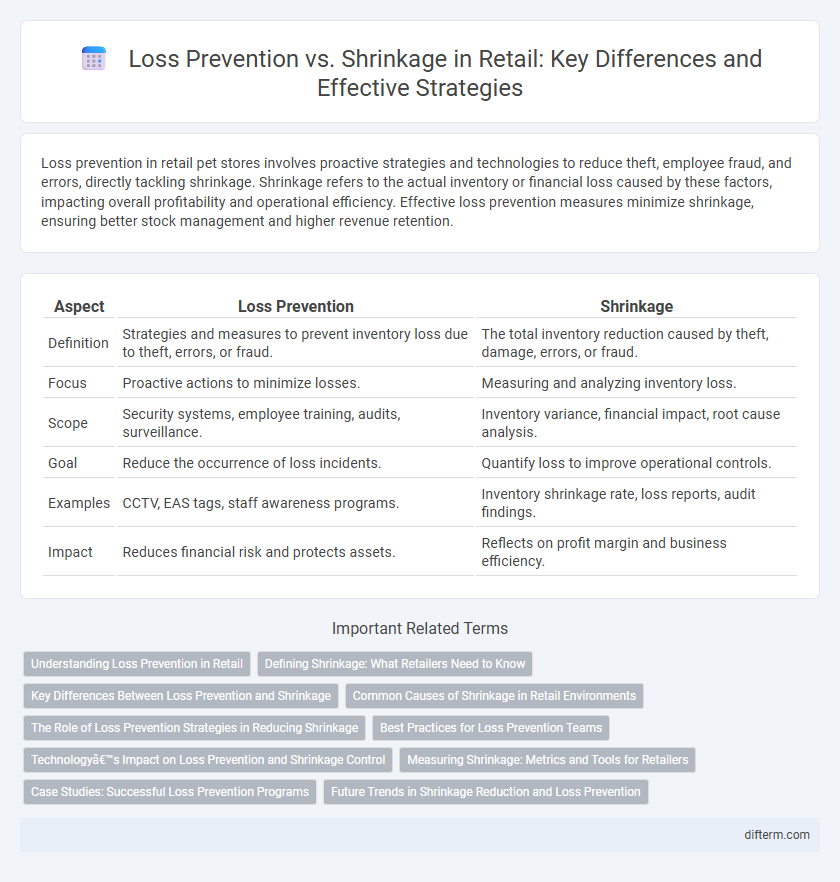Loss prevention in retail pet stores involves proactive strategies and technologies to reduce theft, employee fraud, and errors, directly tackling shrinkage. Shrinkage refers to the actual inventory or financial loss caused by these factors, impacting overall profitability and operational efficiency. Effective loss prevention measures minimize shrinkage, ensuring better stock management and higher revenue retention.
Table of Comparison
| Aspect | Loss Prevention | Shrinkage |
|---|---|---|
| Definition | Strategies and measures to prevent inventory loss due to theft, errors, or fraud. | The total inventory reduction caused by theft, damage, errors, or fraud. |
| Focus | Proactive actions to minimize losses. | Measuring and analyzing inventory loss. |
| Scope | Security systems, employee training, audits, surveillance. | Inventory variance, financial impact, root cause analysis. |
| Goal | Reduce the occurrence of loss incidents. | Quantify loss to improve operational controls. |
| Examples | CCTV, EAS tags, staff awareness programs. | Inventory shrinkage rate, loss reports, audit findings. |
| Impact | Reduces financial risk and protects assets. | Reflects on profit margin and business efficiency. |
Understanding Loss Prevention in Retail
Loss prevention in retail focuses on implementing strategies and technologies to reduce theft, fraud, and operational errors that contribute to inventory shrinkage. Effective loss prevention combines employee training, surveillance systems, and data analytics to identify vulnerabilities and mitigate potential losses. Understanding the distinction between loss prevention as a proactive approach and shrinkage as the outcome highlights the importance of continuous monitoring and improvement in retail operations.
Defining Shrinkage: What Retailers Need to Know
Shrinkage in retail refers to the loss of inventory that can result from theft, administrative errors, or supplier fraud, often quantified as a percentage of sales or inventory value. Understanding shrinkage is critical for retailers to implement effective loss prevention strategies that minimize financial impact and improve profitability. Accurate measurement and analysis of shrinkage help retailers identify vulnerabilities and optimize inventory management systems to reduce overall losses.
Key Differences Between Loss Prevention and Shrinkage
Loss Prevention refers to proactive strategies and measures implemented to deter theft, fraud, and operational errors within retail environments, while Shrinkage represents the actual loss of inventory due to these factors. Key differences lie in their scope; Loss Prevention encompasses policies, employee training, surveillance, and security systems, whereas Shrinkage quantifies the tangible impact of inventory shortfalls often measured as a percentage of sales. Understanding these distinctions enables retailers to develop targeted interventions that both minimize risks and accurately track losses to optimize profitability.
Common Causes of Shrinkage in Retail Environments
Common causes of shrinkage in retail environments include employee theft, shoplifting, administrative errors, and vendor fraud. Inventory mismanagement and poor security measures also contribute significantly to losses. Implementing effective loss prevention strategies targets these areas to reduce overall shrinkage.
The Role of Loss Prevention Strategies in Reducing Shrinkage
Loss prevention strategies play a critical role in reducing retail shrinkage by implementing targeted measures such as employee training, advanced surveillance systems, and rigorous inventory management. Effective loss prevention not only deters theft and fraud but also minimizes administrative errors and supplier-related losses, which collectively contribute to overall shrink reduction. Deploying data analytics and real-time monitoring enhances the ability to identify vulnerabilities, reinforcing operational control and maximizing profitability in the retail sector.
Best Practices for Loss Prevention Teams
Loss prevention teams play a crucial role in minimizing retail shrinkage by implementing advanced inventory control, employee training, and surveillance technologies. Effective loss prevention strategies include real-time data analytics to identify theft patterns, regular audits, and fostering a culture of accountability among staff. Leveraging integrated security systems and maintaining clear communication channels with store personnel significantly enhances the detection and reduction of internal and external theft incidents.
Technology’s Impact on Loss Prevention and Shrinkage Control
Advanced technology like AI-powered surveillance systems and RFID inventory tracking significantly enhances loss prevention by detecting suspicious behavior and reducing human error. Data analytics platforms enable retailers to identify shrinkage patterns, optimize staff allocation, and implement proactive measures. Integrating IoT devices with real-time monitoring further minimizes inventory loss by providing instant alerts and detailed audit trails.
Measuring Shrinkage: Metrics and Tools for Retailers
Measuring shrinkage accurately involves tracking key metrics such as inventory variance, sales discrepancies, and employee-related losses using advanced tools like RFID systems, point-of-sale analytics, and video surveillance. Retailers analyze shrink rate percentages and dollar-value losses regularly to identify patterns and pinpoint high-risk areas. Implementing integrated software platforms enhances real-time monitoring, enabling proactive loss prevention strategies and minimizing overall shrinkage impact.
Case Studies: Successful Loss Prevention Programs
Successful loss prevention programs have demonstrated significant reductions in retail shrinkage by implementing advanced surveillance technologies and employee training initiatives. Case studies from major retailers reveal that integrating real-time analytics with inventory management systems can decrease theft-related losses by up to 30%. Data-driven strategies focusing on both internal and external theft sources contribute to sustainable shrinkage control and increased profit margins.
Future Trends in Shrinkage Reduction and Loss Prevention
Emerging technologies such as AI-powered video analytics and IoT sensors are revolutionizing loss prevention by enabling real-time theft detection and predictive analytics. Retailers are increasingly adopting blockchain for transparent inventory tracking, significantly reducing shrinkage caused by fraud and errors. Future trends also emphasize employee training programs enhanced by virtual reality simulations to improve loss prevention effectiveness and reduce operational shrinkage.
Loss Prevention vs Shrinkage Infographic

 difterm.com
difterm.com